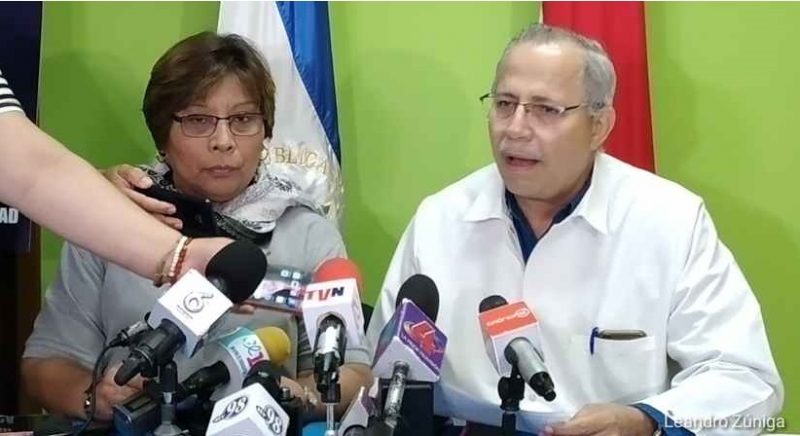New Protocol an “Implicit Admission” of Covid-19 Spread in Nicaragua

By Cinthya Torrez Garcia (La Prensa)
HAVANA TIMES – The Nicaraguan Ministry of Health (Minsa) circulated a new memo to all those in the health centers and public and private hospitals, directing them to establish a triage system to classify patients with respiratory symptoms. This protocol is now circulating over social media, but its authenticity has been confirmed by independent doctors.
In addition, the memo asks each health entity to designate a [separate] entrance to receive patients suspected of having Covid-19 and who are awaiting the testing results. These measures are being put into place as the country heads towards an ascending curve of contagion. Doctors have confirmed cases of health personnel in the country infected by the SARS-CoV-2 virus.
Epidemiologist Alvaro Ramirez explains that the communique represents the Ministry’s recognition of the growing situation, which has reached the level of a demand that requires national preparation. “It’s an implicit admission”, Ramirez states. However, he warns that these measures are being taken late: epidemiological data regarding the illness’s possible impact in the country had been made known months earlier, with the objective of guiding preparations for the epidemic. This wasn’t done until now, at the last minute, in the midst of the epidemic.
The cases that have been made known up until now don’t reflect the reality of current infections, because these people became infected three or four weeks ago, the epidemiologist recalls.
It’s also imperative that “any patient suspected of Covid-19 should be issued a disposable mask,” the document affirms. Once a suspected case is identified, the triage personnel should inform the health center’s director, who in turn must inform the director of local health services. Doctors told the La Prensa newpaper that the newly issued Minsa document represents the official ministry guidelines for attending to patients with symptoms of Covid-19.
Government’s “double-speak”
Ramirez believes that “there’s double-speak in everything the government’s doing.” On the one hand, they maintain the official position that there’s no community transmission and won’t admit that the pandemic is evolving in the country, but under the radar they’re taking a series of measures.
Real data on the number of Covid-19 cases registered in Nicaragua can’t be found anywhere. The social networks have been flooded with denunciations of supposed cases of the novel Coronavirus in Chinandega, and a number of medical sources have confirmed that there are patients in that city’s Hospital Espana and that twelve health workers have been infected. The organization Nicaraguan Medical Unity [Unidad Médica Nicaragüense] has counted 42 cases of infected health personnel in the country up through Tuesday, May 5.
After an initial Minsa protocol asserting that the country had 19 hospitals ready to face the epidemic, now they are asking that each healthcare center prepare a separate area for suspected cases of Covid-19. Ramirez questions whether all personnel with or without training will be involved, without protective equipment. These are decisions that should have been taken two months ago, together with the necessary preparation and training. They are only now being taken, “in the heat of it, with the increase in cases and evident community transmission that can’t be denied,” he notes.
Carlos Quant a specialist in infectious diseases and a member of the Multidisciplinary Scientific Committee, asserts that Minsa’s brief protocol memo on the response to Covid-19 cases is “better late than never” for the Ministry. He agrees with epidemiologist Alvaro Ramirez that the measures are a little late, and alleges that this kind of protocol should have been prepared long before the epidemic, which had allowed Nicaragua a certain margin of time before the substantial increase in patients with suspected cases of Covid-19 began to be seen.
What no one wanted was a great number of patients going to the hospital, as is now happening, and will continue to happen, the infectious disease specialist explains. These protocols are guides, not “strait-jackets”, he notes in reference to the document’s being in accordance with the recommended management of the Coronavirus.
Criteria for hospitalization and release
Up until now, Minsa continues to report 16 total confirmed cases of Covid-19 in the country since March 18, when the first case was reported. Of these patients, five have died. In this new protocol, Minsa establishes seven medical criteria for the hospitalization of a suspected or confirmed Covid-19 patient.
Criteria for admission include: a citizen whose respiratory rate surpasses 25 breaths a minute; having difficulty breathing; clinical and radiological data indicating non-typical pneumonia; signs of organ failure; or the existence of one or more risk factors, such as being over 60, suffering from non-contagious chronic diseases or having suppressed immune systems.
For releasing a person from the hospital, in the case of patients with mild or moderate disease, their radiological findings should be taken into consideration, with lung images showing a significant improvement, and without signs of organ malfunction. In terms of clinical criteria, the patient should be without fever for 48 hours, and their respiratory frequency should be under 22 breaths per minute, among others.
It’s also required for the patient to have completed five days of treatment with chloroquine, nitazoxanide, azithromycin, lopinavir or ritonavir. They warn that every patient released “will be sent to home quarantine for 21 days from the onset of symptoms have passed.”
Protection for health personnel
In this protocol, Minsa took health personnel into account by mentioning that they should comply strictly with the preventive and protective measures against Covid-19. However, this remained on paper only, since many doctors note that they don’t have the necessary equipment to guarantee their protection at the moment of attending to a confirmed or suspected Covid-19 patient.






Comments are closed.